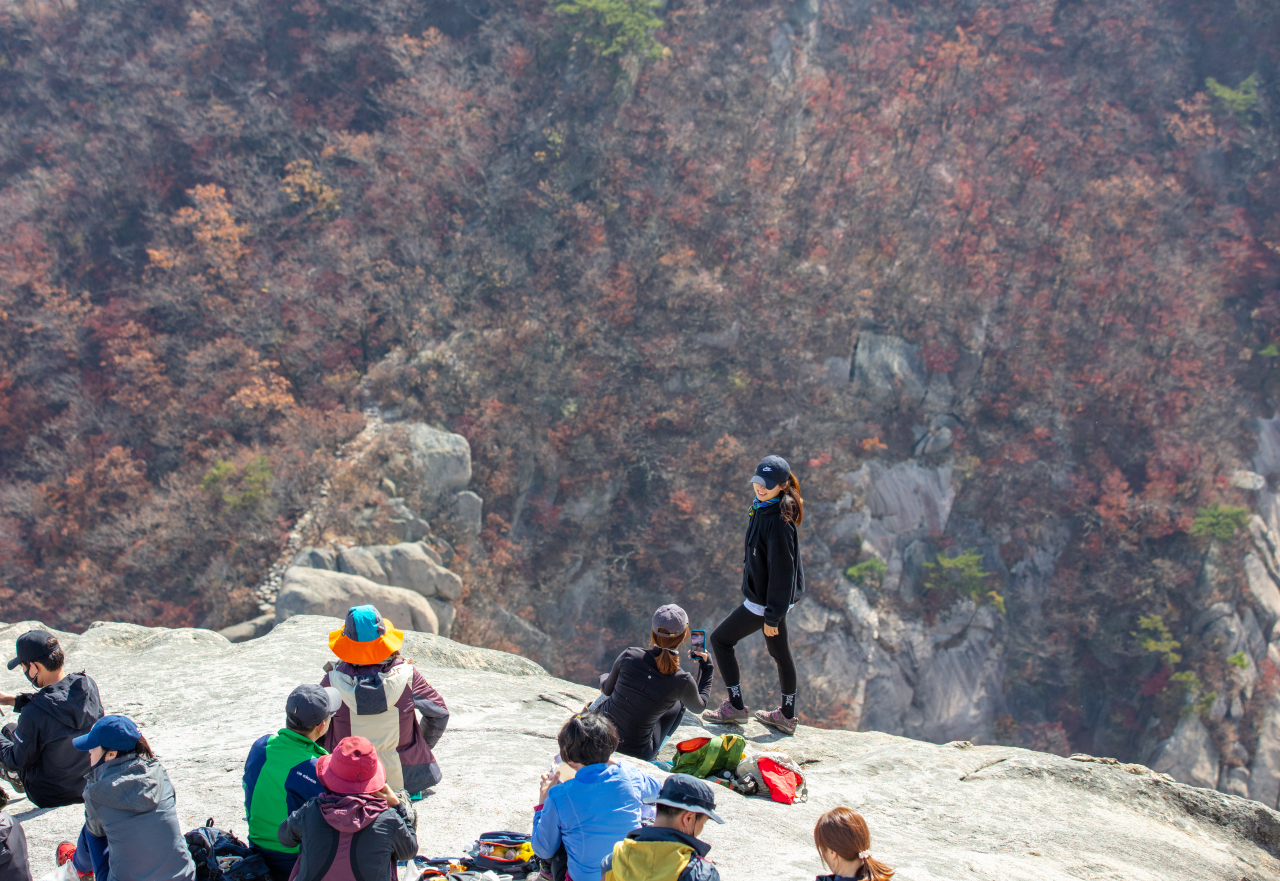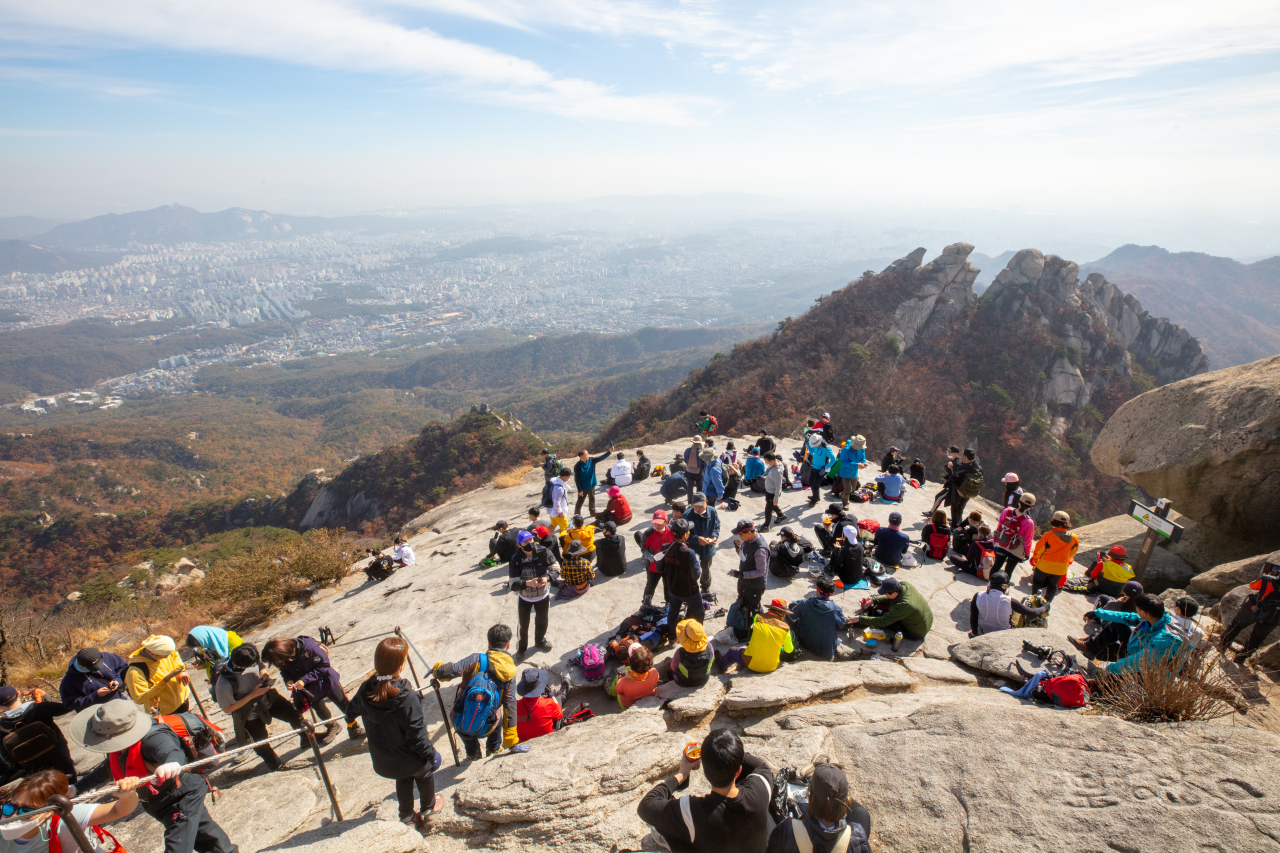[Weekender] Millennials make hiking hip in COVID-19 times
By Lim Jang-wonPublished : Nov. 7, 2020 - 16:01

As the foliage turns to different shades of color, those visiting the mountains for the first time this year will be surprised to see so many people, especially millennials, on the hiking trails at Seoul’s many mountains.
Before the COVID-19 pandemic, hiking was seen as a leisure activity that not many millennials were excited about. Older bosses at work asking their younger colleagues to go hiking together on the weekend was one of the standard nightmares that millennials complained about on social media.
All that has changed in 2020, and hiking has become a defining trend among millennials this year.
Two factors contributed to the hiking trend among millennials: COVID-19 and social media.
Due to COVID-19, South Koreans couldn’t go to gyms or other sports facilities during peak social distancing periods. At the same time, heightened interest in health and immunity led to heightened interest in home training and other physical activities. In addition, being quarantined or stuck indoors left many wanting fresh air outside. People started heading to the mountains, despite having to wear masks.
Still, this year has seen a decrease in the total number of mountaingoers.
“If you look at the total number of people coming to the national parks, the figure has decreased around 18 percent,” said an official at the Korea National Park Service. “National parks that are close to homes and easy to hike got more visitors, while parks outside large cities that people went to in large groups on chartered buses had fewer visitors for the most part.”
Korea National Park Service data showed that as of September, the total number of visitors this year increased only for Gyeryongsan, Bukhansan and Chiaksan, which are all close to large cities. Gyeryongsan visitors rose 16 percent, Chiaksan 24 percent and Bukhansan 19 percent compared with last year’s data.
Jin Joo-young, who has hiked for the past six years and heads the Instagram-based Young Mountaineers Club, for people between the ages of 20 and 35, thinks the number of people on the mountains in Seoul is higher than ever.
“In Seoul, Inwangsan, Ansan and hiking courses in Bukhansan that take only an hour or two to reach the top are especially popular among millennials,” said Jin. “Places like Gwanaksan and Dobongsan also have much more people than in previous years.”
Another factor that drives millennials to the mountains is the popularity of social media.
Numerous Instagram posts with hashtags such as #Deungsan (the Korean word for hiking), #Deungsanstagram (a portmanteau of Instagram and the Korean word for hiking) and #Sanrini (a portmanteau of the Korean words “san,” meaning mountain, and “eorini,” meaning child) could be seen this year.
Before the COVID-19 pandemic, hiking was seen as a leisure activity that not many millennials were excited about. Older bosses at work asking their younger colleagues to go hiking together on the weekend was one of the standard nightmares that millennials complained about on social media.
All that has changed in 2020, and hiking has become a defining trend among millennials this year.
Two factors contributed to the hiking trend among millennials: COVID-19 and social media.
Due to COVID-19, South Koreans couldn’t go to gyms or other sports facilities during peak social distancing periods. At the same time, heightened interest in health and immunity led to heightened interest in home training and other physical activities. In addition, being quarantined or stuck indoors left many wanting fresh air outside. People started heading to the mountains, despite having to wear masks.
Still, this year has seen a decrease in the total number of mountaingoers.
“If you look at the total number of people coming to the national parks, the figure has decreased around 18 percent,” said an official at the Korea National Park Service. “National parks that are close to homes and easy to hike got more visitors, while parks outside large cities that people went to in large groups on chartered buses had fewer visitors for the most part.”
Korea National Park Service data showed that as of September, the total number of visitors this year increased only for Gyeryongsan, Bukhansan and Chiaksan, which are all close to large cities. Gyeryongsan visitors rose 16 percent, Chiaksan 24 percent and Bukhansan 19 percent compared with last year’s data.
Jin Joo-young, who has hiked for the past six years and heads the Instagram-based Young Mountaineers Club, for people between the ages of 20 and 35, thinks the number of people on the mountains in Seoul is higher than ever.
“In Seoul, Inwangsan, Ansan and hiking courses in Bukhansan that take only an hour or two to reach the top are especially popular among millennials,” said Jin. “Places like Gwanaksan and Dobongsan also have much more people than in previous years.”
Another factor that drives millennials to the mountains is the popularity of social media.
Numerous Instagram posts with hashtags such as #Deungsan (the Korean word for hiking), #Deungsanstagram (a portmanteau of Instagram and the Korean word for hiking) and #Sanrini (a portmanteau of the Korean words “san,” meaning mountain, and “eorini,” meaning child) could be seen this year.

Changing fashion
One hashtag that stands out this year is #Deungsanfashion.
Before 2020, middle-aged men and women wearing sun hats and brightly colored professional hiking garb were the norm on mountains in Korea. However, with the growing number of millennials going to less challenging mountains in and around cities, more fashionable yet comfortable ensembles are frequently seen on the trails.
“When I first started climbing six years ago, there was hardly anyone wearing leggings while hiking,” said Jin. “People usually wore outdoor hiking pants that a lot of older generations wear or sported complete hiking outfits. These days the norm among the young generation women is to wear leggings. In addition to leggings, people wear colorful socks or socks from popular brands that cover half of the calves to make a fashion point.”
Many also wear running outfits and running shoes and carry ordinary backpacks, not those specially made for hiking. While the lack of hiking shoes could spell trouble, it also reflects the ease of climbing some of the city’s more popular mountains. Not having to invest in hiking gear was initially appealing for millennials, although many have now started searching for luxury brands of leggings so they can share their new look on social media.
As the “athleisure” look started trending with COVID-19, leggings companies are seeing a huge increase in sales. Popular local leggings brand Andar saw a 47 percent increase in revenue in the first half of 2020 over the same period last year. Even leggings for men are selling out.
“With athleisure life becoming important, athleisure looks have also gained popularity,” said a marketing official at Andar. “As COVID-19 limits the the scope of activities, running, home training and climbing mountains solo started trending, increasing the popularity of leggings.”
People also went to the mountains to take pictures at scenic spots at the top to upload on social media. The lines to take photos at scenic spots and stones or other markers indicating the top of a mountain are longer than ever.
Outdoor clothing brand Black Yak’s Blackyak Alpine Club, which challenges members to climb 100 selected mountains in Korea and document their adventures to win prizes, is highly popular with over 190,000 members.
Another notable trend is that more women are heading to the mountains.
“We have a lot more females in the group, the ratio is about 2-1. Even on the mountains I feel there are a lot more women. I think it’s because of social media,” said Jin.
In addition, social media-based hiking groups for millennials, such as the Young Mountaineers Club, are gaining popularity.
Previously, hiking clubs were often associated with images of middle-aged men and women having affairs.
“I think the impression of hiking clubs is changing. When I first told my parents that I was going to join a hiking club, my mom asked me why I would join a club that probably has just middle-aged men and women. Also, the image that my parents had of such clubs wasn’t that great, either,” said Jin.
Now, hiking clubs have become a place where young, mostly single people can enjoy hiking together. Given those changing demographics, it is not surprising that many hikers eventually find themselves in relationships with fellow club members.
But gone are the days of eating, drinking and socializing after a hike. With the pandemic, hiking crews have limited their official activities to hiking.
By Lim Jang-won (ljw@heraldcorp.com)
One hashtag that stands out this year is #Deungsanfashion.
Before 2020, middle-aged men and women wearing sun hats and brightly colored professional hiking garb were the norm on mountains in Korea. However, with the growing number of millennials going to less challenging mountains in and around cities, more fashionable yet comfortable ensembles are frequently seen on the trails.
“When I first started climbing six years ago, there was hardly anyone wearing leggings while hiking,” said Jin. “People usually wore outdoor hiking pants that a lot of older generations wear or sported complete hiking outfits. These days the norm among the young generation women is to wear leggings. In addition to leggings, people wear colorful socks or socks from popular brands that cover half of the calves to make a fashion point.”
Many also wear running outfits and running shoes and carry ordinary backpacks, not those specially made for hiking. While the lack of hiking shoes could spell trouble, it also reflects the ease of climbing some of the city’s more popular mountains. Not having to invest in hiking gear was initially appealing for millennials, although many have now started searching for luxury brands of leggings so they can share their new look on social media.
As the “athleisure” look started trending with COVID-19, leggings companies are seeing a huge increase in sales. Popular local leggings brand Andar saw a 47 percent increase in revenue in the first half of 2020 over the same period last year. Even leggings for men are selling out.
“With athleisure life becoming important, athleisure looks have also gained popularity,” said a marketing official at Andar. “As COVID-19 limits the the scope of activities, running, home training and climbing mountains solo started trending, increasing the popularity of leggings.”
People also went to the mountains to take pictures at scenic spots at the top to upload on social media. The lines to take photos at scenic spots and stones or other markers indicating the top of a mountain are longer than ever.
Outdoor clothing brand Black Yak’s Blackyak Alpine Club, which challenges members to climb 100 selected mountains in Korea and document their adventures to win prizes, is highly popular with over 190,000 members.
Another notable trend is that more women are heading to the mountains.
“We have a lot more females in the group, the ratio is about 2-1. Even on the mountains I feel there are a lot more women. I think it’s because of social media,” said Jin.
In addition, social media-based hiking groups for millennials, such as the Young Mountaineers Club, are gaining popularity.
Previously, hiking clubs were often associated with images of middle-aged men and women having affairs.
“I think the impression of hiking clubs is changing. When I first told my parents that I was going to join a hiking club, my mom asked me why I would join a club that probably has just middle-aged men and women. Also, the image that my parents had of such clubs wasn’t that great, either,” said Jin.
Now, hiking clubs have become a place where young, mostly single people can enjoy hiking together. Given those changing demographics, it is not surprising that many hikers eventually find themselves in relationships with fellow club members.
But gone are the days of eating, drinking and socializing after a hike. With the pandemic, hiking crews have limited their official activities to hiking.
By Lim Jang-won (ljw@heraldcorp.com)
-
Articles by Lim Jang-won







![[Graphic News] More Koreans say they plan long-distance trips this year](http://res.heraldm.com/phpwas/restmb_idxmake.php?idx=644&simg=/content/image/2024/04/17/20240417050828_0.gif&u=)
![[KH Explains] Hyundai's full hybrid edge to pay off amid slow transition to pure EVs](http://res.heraldm.com/phpwas/restmb_idxmake.php?idx=644&simg=/content/image/2024/04/18/20240418050645_0.jpg&u=20240419100350)






![[From the Scene] Monks, Buddhists hail return of remains of Buddhas](http://res.heraldm.com/phpwas/restmb_idxmake.php?idx=652&simg=/content/image/2024/04/19/20240419050617_0.jpg&u=20240419175937)

![[KH Explains] Hyundai's full hybrid edge to pay off amid slow transition to pure EVs](http://res.heraldm.com/phpwas/restmb_idxmake.php?idx=652&simg=/content/image/2024/04/18/20240418050645_0.jpg&u=20240419100350)

![[Today’s K-pop] Illit drops debut single remix](http://res.heraldm.com/phpwas/restmb_idxmake.php?idx=642&simg=/content/image/2024/04/19/20240419050612_0.jpg&u=)